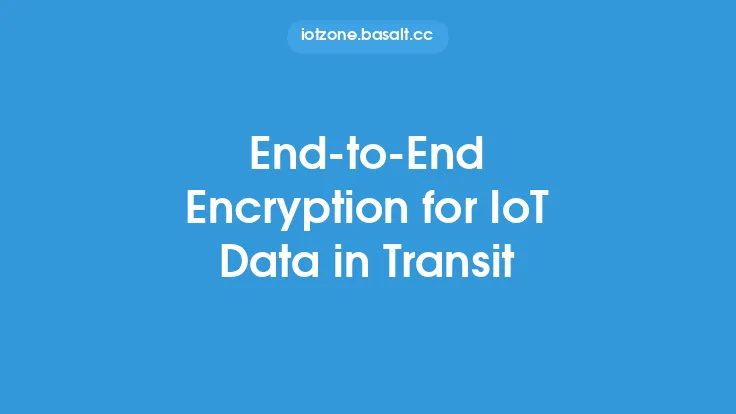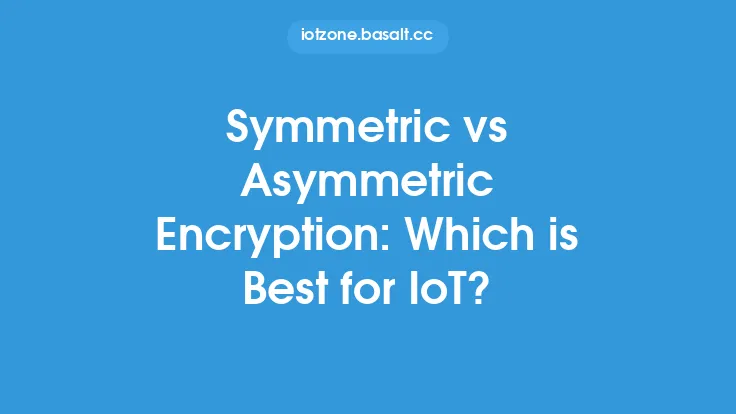The increasing reliance on the Internet of Things (IoT) has led to a growing concern about the security of these devices and the data they transmit. As the number of connected devices continues to rise, the potential attack surface expands, making it essential to implement robust security measures to protect against unauthorized access and data breaches. One critical aspect of IoT security is encryption, which ensures that even if data is intercepted, it remains unreadable to unauthorized parties. However, with the advent of quantum computing, traditional encryption methods are facing a significant threat. Quantum computers have the potential to break many encryption algorithms currently in use, which is why quantum-resistant encryption is becoming a crucial aspect of future-proofing IoT security.
What is Quantum-Resistant Encryption?
Quantum-resistant encryption refers to cryptographic techniques that are designed to be secure against attacks by both classical and quantum computers. Unlike traditional encryption methods that rely on the difficulty of certain mathematical problems, such as factoring large numbers or computing discrete logarithms, quantum-resistant encryption uses different mathematical problems that are resistant to quantum attacks. These problems include lattice problems, code-based cryptography, hash-based signatures, and multivariate cryptography, among others. The primary goal of quantum-resistant encryption is to ensure that data remains secure even when quantum computers become powerful enough to break current encryption standards.
Lattice-Based Cryptography
Lattice-based cryptography is one of the most promising approaches to quantum-resistant encryption. It is based on the hardness of problems related to lattices, which are high-dimensional arrays of points. Lattice problems, such as the shortest vector problem (SVP) and the closest vector problem (CVP), are believed to be hard for both classical and quantum computers to solve. Lattice-based cryptographic schemes, such as the NTRU encryption scheme and the Ring-LWE (Ring Learning With Errors) key exchange, have been shown to be secure against quantum attacks. These schemes are also relatively efficient and can be implemented on a wide range of devices, making them suitable for IoT applications.
Code-Based Cryptography
Code-based cryptography is another approach to quantum-resistant encryption. It is based on the hardness of decoding random linear codes, which is a problem that has been shown to be hard for both classical and quantum computers. Code-based cryptographic schemes, such as the McEliece encryption scheme, have been around for several decades but have only recently gained attention as a potential solution to the quantum threat. While code-based cryptography is considered to be secure against quantum attacks, it has some drawbacks, such as large key sizes and slow encryption speeds, which can make it less suitable for some IoT applications.
Hash-Based Signatures
Hash-based signatures are a type of digital signature that is based on the hardness of finding collisions in a hash function. They are considered to be quantum-resistant because finding collisions in a hash function is a problem that is hard for both classical and quantum computers. Hash-based signature schemes, such as the Lamport signature scheme and the SPHINCS (Secure Proxy Hash Inner Navigation and Collision) scheme, have been shown to be secure against quantum attacks. However, they have some limitations, such as large signature sizes and the need for a large number of hash functions, which can make them less suitable for some IoT applications.
Multivariate Cryptography
Multivariate cryptography is a type of cryptography that is based on the hardness of solving systems of multivariate polynomial equations. It is considered to be quantum-resistant because solving these equations is a problem that is hard for both classical and quantum computers. Multivariate cryptographic schemes, such as the Rainbow signature scheme and the SIDH (Supersingular Isogeny Diffie-Hellman) key exchange, have been shown to be secure against quantum attacks. However, they have some drawbacks, such as large key sizes and slow encryption speeds, which can make them less suitable for some IoT applications.
Implementing Quantum-Resistant Encryption in IoT
Implementing quantum-resistant encryption in IoT devices requires careful consideration of several factors, including the choice of cryptographic algorithm, key management, and device resources. The choice of algorithm will depend on the specific use case and the requirements of the application. For example, lattice-based cryptography may be suitable for applications that require high-speed encryption, while code-based cryptography may be more suitable for applications that require high security. Key management is also an important consideration, as it is essential to ensure that keys are generated, distributed, and stored securely. Finally, device resources, such as processing power and memory, must be taken into account when implementing quantum-resistant encryption, as some algorithms may require significant resources to operate efficiently.
Future Directions
The development of quantum-resistant encryption is an active area of research, and several organizations, including the National Institute of Standards and Technology (NIST), are working to standardize quantum-resistant cryptographic algorithms. The NIST Post-Quantum Cryptography Standardization Process, which was launched in 2016, aims to develop and standardize quantum-resistant cryptographic algorithms that can be used to protect sensitive information against quantum attacks. The process has already led to the selection of several quantum-resistant algorithms, including lattice-based, code-based, and hash-based signature schemes, which are expected to be standardized in the near future. As the development of quantum-resistant encryption continues to evolve, it is essential to stay informed about the latest developments and to begin planning for the transition to quantum-resistant encryption in IoT devices.
Conclusion
Quantum-resistant encryption is a critical aspect of future-proofing IoT security, as it ensures that data remains secure even when quantum computers become powerful enough to break current encryption standards. Several approaches to quantum-resistant encryption, including lattice-based cryptography, code-based cryptography, hash-based signatures, and multivariate cryptography, have been shown to be secure against quantum attacks. Implementing quantum-resistant encryption in IoT devices requires careful consideration of several factors, including the choice of cryptographic algorithm, key management, and device resources. As the development of quantum-resistant encryption continues to evolve, it is essential to stay informed about the latest developments and to begin planning for the transition to quantum-resistant encryption in IoT devices. By taking proactive steps to implement quantum-resistant encryption, organizations can help ensure the long-term security and integrity of their IoT devices and the data they transmit.





